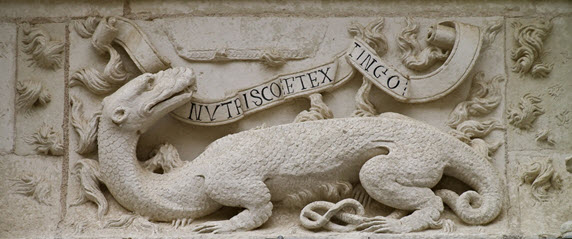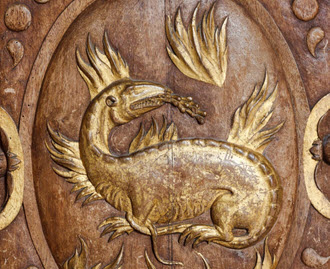28 March 2017
This article features one of our finest new chimneypieces (Stock No. 14516) unites exquisite quality with powerful symbolism in form of a salamander. It is an enchanting combination, telling the tale of royal iconography and revolutionary ambition.
The Salamander is a creature cloaked in mystery. In the 1st century AD Pliny claimed that the Salamander “is so intensely cold as to extinguish fire by its contact, in the same way as ice does.” Later accounts by Aristotle and Leonardo da Vinci contained similarly fantastical observations, Da Vinci believing the salamander, "gets no food but from the fire, in which it constantly renews its scaly skin”. These accounts added to the mystique of the elusive amphibian, and it became valuable for its supposed medicinal and magical purposes.
It was only much later that the salamander was to serve a heraldic purpose for the French Crown. King Francis I was a significant patron of the arts and champion of humanism, who encouraged Leonardo Da Vinci to come to France, and with him, the Mona Lisa, which he later acquired. His reign saw the French exploration of the New World, and with it, expansion of the French colonial empire. Francis had carefully selected the emblem of the salamander to represent him as King, with the accompanying motto, “Nutrisco et extinguo” (I nourish and I extinguish). This emblem was widely used in royal palaces, art and architecture.
Far from being a keen herpetologist, Francis I was aware of the rich symbolism entwined with the mythical creature. Paired with the motto, the salamander becomes symbolic of virtue, nourishing the fires of belief and knowledge and extinguishing the flames of sin and disordered passions. The salamanderalso possessed talisman like properties due to its famed ability to withstand annihilation by flames. It was evenrumoured that Pope Alexander III had a prized garment made of salamander skin. It is now assumedthat this garment was in fact woven from asbestos mined in Tartary, something that was frequently mistaken for hair, or nest, of the salamander. Marco Polo was one of the first to voice his scepticism, identified asbestos as the source of the legend.

The Emblem of Francis I
The emblem of the salamander expanded beyond the royal household and became a feature within many other grand homes in France. One chimneypiece in our collection bears particularly fine renderings of this insignia. Made in France in the late 19th century, the walnut trumeau chimneypiece features two representations of the salamander engulfed by flames. Strikingly similar to the salamanders embellishing the grand Fontainebleau Palace, these emblematic creatures bear little resemblance to a salamander, and instead resemble a dragon, covered in scales and breathing fire.
In addition to the salamander, the original cast iro back plate is enriched with bees on the side panels. Again, this is known to serve a powerful symbolic function. Napoleon Bonaparte adopted bees as his emblem after his ascension to Emperor, bringing legitimacy to his imperial pretentions. In fact considered the oldest emblem of the sovereigns in France, the bee was chosen to link the new dynasty to the very foundations of the nation. The 4th century tomb of Childeric I had only been discovered in the 17th century, and with it, a vast array of fine jewels, including bees carved from precious stone and finely tooled gold. Childeric I was one of the first Merovingians, who had conquered the Visigoths, Saxons, and Alemanni to establish much of Francia: now France. The association with one of the founding fathers of the French nation was a powerful one for Napoleon, and bees, much like the salamander appeared not only in royal palaces but in the homes of aristocrats.
More photos


Detail from Fountaineblue Palace